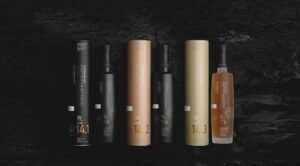By Richard Thomas
 Bruichladdich Distillery brings together two distinct threads. Although the distillery dates back to the late 19th Century, it was shuttered in 1994, and Bruichladdich as a whisky brand really dates to its reopening under entrepreneur Mark Reynier and Master Distiller Jim McEwan in 2000. Much as he did with Waterford Distillery in Ireland, Reynier put Bruichladdich on a path that was grain-centric, focusing more on the inherent flavor of the new make whisky than on the flavors drawn from the casks through maturation. The other thread is that Bruichladdich is an Islay distillery, and like all whisky-makers on that island, peated malts are at the heart of what they do.
Bruichladdich Distillery brings together two distinct threads. Although the distillery dates back to the late 19th Century, it was shuttered in 1994, and Bruichladdich as a whisky brand really dates to its reopening under entrepreneur Mark Reynier and Master Distiller Jim McEwan in 2000. Much as he did with Waterford Distillery in Ireland, Reynier put Bruichladdich on a path that was grain-centric, focusing more on the inherent flavor of the new make whisky than on the flavors drawn from the casks through maturation. The other thread is that Bruichladdich is an Islay distillery, and like all whisky-makers on that island, peated malts are at the heart of what they do.
Those two features are on full display in Bruichladdich’s Octomore, now in its 14th installment. This year’s batch has three separate expressions, and because they really are meant to be taken together and as a cohesive picture, I’ll be departing from the usual practice at The Whiskey Reviewer and evaluating them as a group. These are all five year old single malts, bottled at cask strength and with no coloring or chill filtration. Past that, the details vary markedly.
Octomore 14.1 is the foundation expression, made from Scots-grown Concerto barley and peated to 128.p PPM. It was aged entirely in first-fill ex-bourbon barrels, and bottled at 59.6% ABV.
The 14.2 takes that same malted barley (it’s the same sourcing and peated to the same level), but then matures it in mostly second-fill Amarone casks and Oloroso hogsheads, with some first-fill Amarone casks to round things out. It was bottled at 57.7% ABV.
The final bottling, 14.3, is where the grain diverges. It’s also Concerto barley, but grown on Islay itself. This was peated all the way up to 214.2 ppm, and matured in first-fill ex-bourbon barrels and second fill ex-European oak casks. The cask strength here came out at 61.4% ABV.
The Scotch
First, I found that none of these Octomores actually requires water. They aren’t even remotely hot as is, and a few drops or even a splash of water doesn’t really do much to improve on/open up their character. That is the most impressive part of these whiskies: three youthful, cask strength single malts (one of them over 120 proof) that are not just thoroughly approachable, but are at their best straight from the bottle.
14.1, Rating: B
This golden pour has a nose that smacks with creosote and green wood, with an after-scent of stove-top cooked, lightly toasted barley. The palate led with honey and cinnamon, with creosote rising up and swamping the flavor. The finish was equal parts ashy and generic cough syrup.
14.2, Rating: B
My thinking is that 14.1 was held back by its finish, barely qualified as a B, and is definitely not worth the asking price. Octomore 14.2 does better. It too has a golden look to it, but the nose has a powerful oily current, with heavily toasted cereals lying underneath. The flavor was like a smoky Red Hot, except it has that distinction between being spiced and being spicy. By this, I mean think about the difference between spiced wine and a curry. The finish led with ash, which gave way to that spiced-with-cinnamon note again.
14.3, Rating: B+
Despite being the same age and not relying entirely on first-fill wine casks or somesuch thing, the color for this one shifted from gold into light bronze. Somehow, the nose is even oilier than 14.2, but is otherwise quite similar to the second Octomore 14: sweet and spiced, but not actually spicy. That Red Hots character is back, but leans sweeter than 14.2. Again, the finish opens with ash and gives way to cinnamon. Despite having almost twice the PPM, the whisky is not really all that much smokier.
The Price
Each bottle is $220.
 The Whiskey Reviewer A World of Whiskey, Poured Every Weekday
The Whiskey Reviewer A World of Whiskey, Poured Every Weekday

One comment
Pingback: Bruichladdich Black Arts 11.1 Scotch Assessment (2023) - Tasty Bites Journey